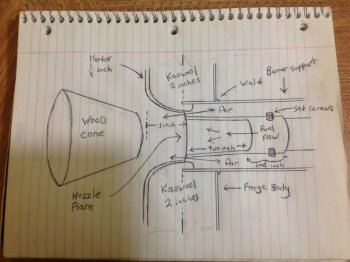Am I correct in thinking that the drawing depicts how you intend to setup the forge liner for a burner....or is the actual burner part of what you've pictured?
There are several things that experience has taught me are either not necessary, or that will cause issues later.....
-I know that using 2" of kawool is the popular thing to do these days, but in reality it's a waste. The common thinking is that if 1" of kawool is good, then 2" must be better.....it's just not so. (assuming that both the kawool is #8 density). 2" of kawool takes more time and fuel to reach and hold a given temp then 1"...it's the design nature of the material. Ceramic Fiber blanket insulators are designed to absorb a given amount of heat before they start reflecting....as thickness increases, the amount of heat absorbed increases before it starts reflecting the heat, and the more heat it holds versus reflecting. This equates to the simple fact that a forge built with 2" of ceramic fiber liner will use more fuel then a forge with 1" of ceramic fiber to achieve/maintain the same level of heat.
-Unless the plan is to coat the entire interior with a layer of "fire mortar", the cone shape will not hold for more then a few firing/cooling cycles of the forge, before the fire mortar starts cracking/breaking away. The biggest issue that most people have with any of the "coatings" is being patient..... you cannot force them to cure, and have them last. Anything other then allowing a coating to naturally dry/cure, and you dramatically shorten it's life.....most people simply don't have the patience to allow the coatings to fully cure naturally.....but it's worth the wait. Sometimes it takes a month or longer depending on the climate you live in.
-In my experience the cone shape itself creates more problems then it solves, especially if the end of the burner (where the flame exits) is not extended to at least the interior edge of the forge liner. If the burner is "inset" the mortar cracks during use, and the flame starts working it's way in between the kawool liner and the forge body...... it's difficult to explain, but it happens, and generally means you have to overhaul the lining to correct. A straight hole in the liner, with the burner situated at the correct angle, tangent, and seated to the correct depth (the "flame" end of the burner should extend
slightly past the liner on the interior).
-I also question the length of the burner you will use? A short length burner always has more issues, that a longer burner will not. The length of a forge burner needs to be enough to ensure a good fuel/air mix..... this is generally accomplished via added length in a "straight" burner configuration, of through the use of elbows in a blower type burner. The better the fuel/air mix, the better the "burn" will be, and the easier the burner will be to adjust/control.
-When you say
There is atmospheric air flow between the burner nozzle and the burner support tube.
that troubles me too. That air space will allow for excessive heat to "back flow" around the burner tube, creating a greater possibility of "pre-ignition".... meaning that once the forge/burner have heated up, there may be issues with the fuel/air being ignited inside the burner tube if the burner itself isn't long enough to remain cool at the point where the fuel enters. Ideally, ignition should take place at the very end of the interior (the end inside the forge).
All of those suggestions are based on experience, but take them in the context of the amount of time you run your forge. I suspect I put much more wear and tear on a forge then most. My forges run nearly every day of the week, and 8-10 hours a day....so if you are only using the forge occasionally, and not for long durations at a time, you may not see some of the things I mentioned with the design. That being said, the things I mentioned with likely occur, it will just take longer for them to show up if you don't use the forge as much/hard as I do.


